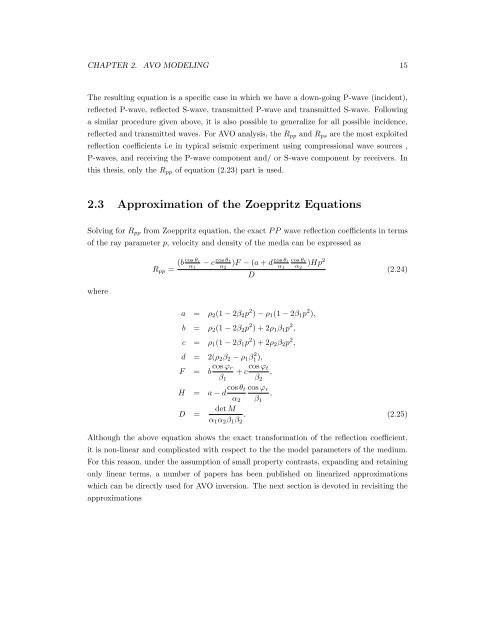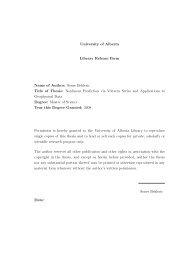Regularization of the AVO inverse problem by means of a ...
Regularization of the AVO inverse problem by means of a ...
Regularization of the AVO inverse problem by means of a ...
You also want an ePaper? Increase the reach of your titles
YUMPU automatically turns print PDFs into web optimized ePapers that Google loves.
CHAPTER 2. <strong>AVO</strong> MODELING 15<br />
The resulting equation is a specific case in which we have a down-going P-wave (incident),<br />
reflected P-wave, reflected S-wave, transmitted P-wave and transmitted S-wave. Following<br />
a similar procedure given above, it is also possible to generalize for all possible incidence,<br />
reflected and transmitted waves. For <strong>AVO</strong> analysis, <strong>the</strong> Rpp and Rps are <strong>the</strong> most exploited<br />
reflection coefficients i.e in typical seismic experiment using compressional wave sources ,<br />
P-waves, and receiving <strong>the</strong> P-wave component and/ or S-wave component <strong>by</strong> receivers. In<br />
this <strong>the</strong>sis, only <strong>the</strong> Rpp <strong>of</strong> equation (2.23) part is used.<br />
2.3 Approximation <strong>of</strong> <strong>the</strong> Zoeppritz Equations<br />
Solving for Rpp from Zoeppritz equation, <strong>the</strong> exact P P wave reflection coefficients in terms<br />
<strong>of</strong> <strong>the</strong> ray parameter p, velocity and density <strong>of</strong> <strong>the</strong> media can be expressed as<br />
where<br />
Rpp =<br />
(b cos θi<br />
α1<br />
cos θt<br />
cos θi cos θt<br />
− c )F − (a + d α2 α1 α2 )Hp2<br />
D<br />
a = ρ2(1 − 2β2p 2 ) − ρ1(1 − 2β1p 2 ),<br />
b = ρ2(1 − 2β2p 2 ) + 2ρ1β1p 2 ,<br />
c = ρ1(1 − 2β1p 2 ) + 2ρ2β2p 2 ,<br />
d = 2(ρ2β2 − ρ1β 2 1),<br />
cos ϕr cos ϕt<br />
F = b + c ,<br />
β1<br />
β2<br />
(2.24)<br />
H =<br />
cos θt cos ϕr<br />
a − d ,<br />
α2 β1<br />
D =<br />
det M<br />
. (2.25)<br />
α1α2β1β2<br />
Although <strong>the</strong> above equation shows <strong>the</strong> exact transformation <strong>of</strong> <strong>the</strong> reflection coefficient,<br />
it is non-linear and complicated with respect to <strong>the</strong> <strong>the</strong> model parameters <strong>of</strong> <strong>the</strong> medium.<br />
For this reason, under <strong>the</strong> assumption <strong>of</strong> small property contrasts, expanding and retaining<br />
only linear terms, a number <strong>of</strong> papers has been published on linearized approximations<br />
which can be directly used for <strong>AVO</strong> inversion. The next section is devoted in revisiting <strong>the</strong><br />
approximations









